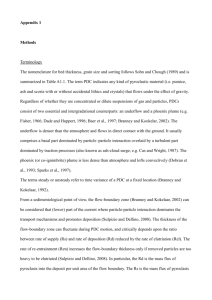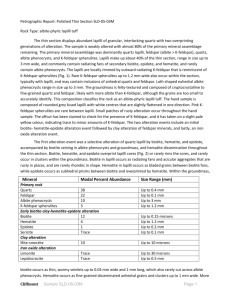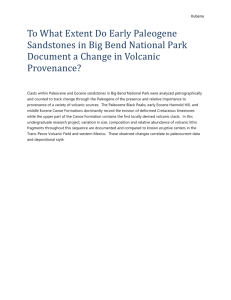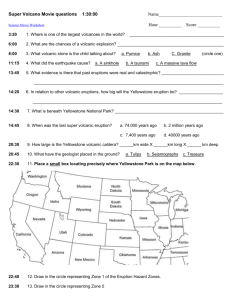Vazev_a2
advertisement
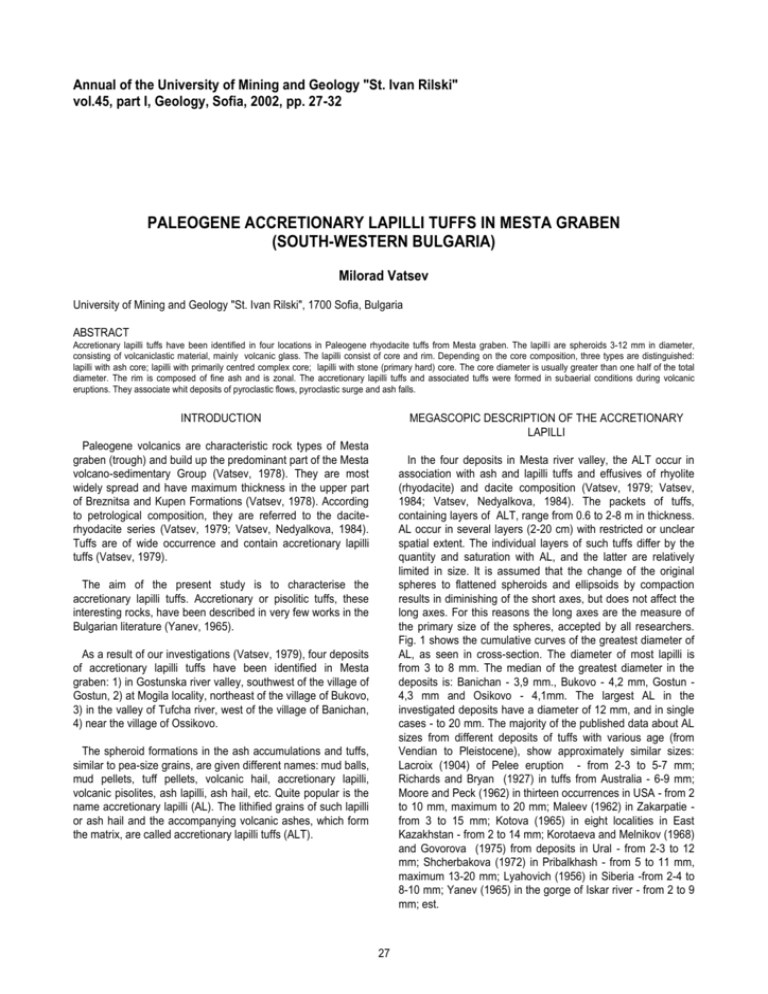
Annual of the University of Mining and Geology "St. Ivan Rilski" vol.45, part I, Geology, Sofia, 2002, pp. 27-32 PALEOGENE ACCRETIONARY LAPILLI TUFFS IN MESTA GRABEN (SOUTH-WESTERN BULGARIA) Milorad Vatsev University of Mining and Geology "St. Ivan Rilski", 1700 Sofia, Bulgaria ABSTRACT Accretionary lapilli tuffs have been identified in four locations in Paleogene rhyodacite tuffs from Mesta graben. The lapilli are spheroids 3-12 mm in diameter, consisting of volcaniclastic material, mainly volcanic glass. The lapilli consist of core and rim. Depending on the core composition, three types are distinguished: lapilli with ash core; lapilli with primarily centred complex core; lapilli with stone (primary hard) core. The core diameter is usually greater than one half of the total diameter. The rim is composed of fine ash and is zonal. The accretionary lapilli tuffs and associated tuffs were formed in subaerial conditions during volcanic eruptions. They associate whit deposits of pyroclastic flows, pyroclastic surge and ash falls. INTRODUCTION MEGASCOPIC DESCRIPTION OF THE ACCRETIONARY LAPILLI Paleogene volcanics are characteristic rock types of Mesta graben (trough) and build up the predominant part of the Mesta volcano-sedimentary Group (Vatsev, 1978). They are most widely spread and have maximum thickness in the upper part of Breznitsa and Kupen Formations (Vatsev, 1978). According to petrological composition, they are referred to the daciterhyodacite series (Vatsev, 1979; Vatsev, Nedyalkova, 1984). Tuffs are of wide occurrence and contain accretionary lapilli tuffs (Vatsev, 1979). In the four deposits in Mesta river valley, the ALT occur in association with ash and lapilli tuffs and effusives of rhyolite (rhyodacite) and dacite composition (Vatsev, 1979; Vatsev, 1984; Vatsev, Nedyalkova, 1984). The packets of tuffs, containing layers of ALT, range from 0.6 to 2-8 m in thickness. AL occur in several layers (2-20 cm) with restricted or unclear spatial extent. The individual layers of such tuffs differ by the quantity and saturation with AL, and the latter are relatively limited in size. It is assumed that the change of the original spheres to flattened spheroids and ellipsoids by compaction results in diminishing of the short axes, but does not affect the long axes. For this reasons the long axes are the measure of the primary size of the spheres, accepted by all researchers. Fig. 1 shows the cumulative curves of the greatest diameter of AL, as seen in cross-section. The diameter of most lapilli is from 3 to 8 mm. The median of the greatest diameter in the deposits is: Banichan - 3,9 mm., Bukovo - 4,2 mm, Gostun 4,3 mm and Osikovo - 4,1mm. The largest AL in the investigated deposits have a diameter of 12 mm, and in single cases - to 20 mm. The majority of the published data about AL sizes from different deposits of tuffs with various age (from Vendian to Pleistocene), show approximately similar sizes: Lacroix (1904) of Pelee eruption - from 2-3 to 5-7 mm; Richards and Bryan (1927) in tuffs from Australia - 6-9 mm; Moore and Peck (1962) in thirteen occurrences in USA - from 2 to 10 mm, maximum to 20 mm; Maleev (1962) in Zakarpatie from 3 to 15 mm; Kotova (1965) in eight localities in East Kazakhstan - from 2 to 14 mm; Korotaeva and Melnikov (1968) and Govorova (1975) from deposits in Ural - from 2-3 to 12 mm; Shcherbakova (1972) in Pribalkhash - from 5 to 11 mm, maximum 13-20 mm; Lyahovich (1956) in Siberia -from 2-4 to 8-10 mm; Yanev (1965) in the gorge of Iskar river - from 2 to 9 mm; est. The aim of the present study is to characterise the accretionary lapilli tuffs. Accretionary or pisolitic tuffs, these interesting rocks, have been described in very few works in the Bulgarian literature (Yanev, 1965). As a result of our investigations (Vatsev, 1979), four deposits of accretionary lapilli tuffs have been identified in Mesta graben: 1) in Gostunska river valley, southwest of the village of Gostun, 2) at Mogila locality, northeast of the village of Bukovo, 3) in the valley of Tufcha river, west of the village of Banichan, 4) near the village of Ossikovo. The spheroid formations in the ash accumulations and tuffs, similar to pea-size grains, are given different names: mud balls, mud pellets, tuff pellets, volcanic hail, accretionary lapilli, volcanic pisolites, ash lapilli, ash hail, etc. Quite popular is the name accretionary lapilli (AL). The lithified grains of such lapilli or ash hail and the accompanying volcanic ashes, which form the matrix, are called accretionary lapilli tuffs (ALT). 27 Vatsev M. PALEOGENE ACCRETIONARY LAPILLI TUFFS IN MESTA … AL from localities in the valley of Mesta river have the shape of flattened spheroids, flattened in the bedding plane (S1). The ratio between the long and short axis in sections perpendicular to the bedding has been measured in 10 grains for each deposit. The average values of these ratios are as follows: Gostun - 1,41; Bukovo - 1,43; Banichan - 1,38 and Osikovo 1,39. In the second case, the centre of accretionary lapilli core contains volcaniclastic grains or fragments of AL. The first ones have diameter of 0,25-0,5 mm, and are considerably more coarse-grained than the grains, building the core. When the rock fragment is small and flattened-elongated or irregular, it is partially surrounded by volcanic ashes with silt size, and they form together a spheroid core. In such case the ash in the core is in small quantities and is unevenly distributed. The greatest thickness is observed over the flat and slightly convex walls and the smallest one - over the sharp, convex outwards edges of the fragments. The shape, size and petrographic composition of the small fragments, serving as cores of some AL, are similar to those of the matrix and of the tuffs, associating with them. The cores of few AL consist of fragments of other broken AL. Fragments of this type are elongated. Their outlines contain parts of outer spherical surface of lapilli and uneven, ribbed sections with marks of breaking. Elements of the concentric structure of the envelope are observed in them as well. These data indicate in a convincing way the dynamic character of the AL generation. They were broken not only by falling on the earth, but also simultaneously with their formation, most probably in a turbulent pyroclastic cloud. Broken lapilli are mixed with unbroken ones in specimens from every locality – Table I – 14 -16. The quantity of AL with primary hard-stone cores is relatively smaller. Such cores are built of fragments of volcanic rocks (rhyodacite, dacite), volcanic glass or of quartz and/or feldspar crystals with or without stickers of volcanic glass. The fragments are flat, elongated or irregular, slightly rounded, 2-8 mm in size, but there are also individuals up to 20 mm. In some cases the core is entirely built of stone and is covered by a rim of fine ash or has a negligible sticker of ash at the flat and concave walls. Figure 1. Cumulative curves of the greatest diameter of accretionary lapilli as seen in section across bedding. AL usually contain a core and a rim (shell). Depending on the core composition, three types of lapilli have been distinguished: a) lapilli with ash core; b) lapilli with primarily centred complex core; c) lapilli with stone (primary hard) core - Table 1- 1-13. The AL with ash core are prevalent. Such cores are built of volcanic ashes, which is more coarse-grained than the peripheral parts. The disposition of ash particles in these cores is in disorder. The core centre is usually built of coarser grains, which diminish from the inside outwards. The majority of accretionary lapilli cores have spherical shape, some of them are slightly elongated or slightly flattened and have spheroid shape. In rare cases, the cores are of more complicated shape, caused by sticking together of two cores, coated subsequently by several thin layers. The core diameter is usually greater than one half of the total diameter of the lapilli. One or several fine-grained concentric layers, composed by relatively finer - pelitic volcanic ash, surround the accretionary lapilli core. The boundary between the core and the rim is transitional and clear, but not an abrupt one. Depending on the different ratios between grain diameter and rim thickness and structure, two types of AL have been distinguished: a) AL with complex concentric rim; b) AL with surface rim - Table 1. A characteristic feature of the AL with complex concentric rim is that it is composed by several fine-grained layers, and the core size is not as large as compared to the whole lapilli. The layers of the rim are mainly thin, delicate and fragile, and envelope tightly the core. They differ in colour and in the size of the building them grains. Individual layers of the rim in some lapilli are much thinner at one point compared to another; other layer or layers are discontinued, covered by another layers and form odd “angular unconformity”. It is characteristic that some layers or the rim become thinner over convex outwards edges. The thickness of the layers and the rim of strongly flattened AL is greater in their borders. According to Moore and Peck (1962) this is due probably to the flattening of the grains and is not a primary feature. This opinion is maintained also by the bending and tearing of a part of the rim – Table 1. Peculiar varieties of lapilli cores are those ones with primary formed centre and complicated structure. Primary centres, around which such lapilli are generated, in some cases are represented by small accretionary lapilli or fragments of them, and in other cases - by sand-size volcaniclastic grains. In the first case, the centre of the lapilli cores contains small AL - 1-3 mm in diameter. Volcanic ashes, mainly with silt grain size, surround this inner small AL. That outer envelope, actually is a outer part of core of the large lapillus and its thickness is greater or equal to the diameter of the inner lapillus. Such complex cores are surrounded by an outer rim, which is identical to the rims of all other AL. ANNUAL University of Mining and Geology “St. Ivan Rilski”, vol. 45 (2002), part I G E O L O G Y 28 Vatsev M. PALEOGENE ACCRETIONARY LAPILLI TUFFS IN MESTA … TABLE I ANNUAL University of Mining and Geology “St. Ivan Rilski”, vol. 45 (2002), part I G E O L O G Y 29 Vatsev M. PALEOGENE ACCRETIONARY LAPILLI TUFFS IN MESTA … Table I 1 – Accretionary lapilli with thick outer layer (rim) and ash core (diameter of the accretionary lapill of photo 1-16 is 7-12 mm). 2 - Accretionary lapilli with thick zonal outer layer and ash core; darker layers are finer grained. 3 - Accretionary lapilli with fine outer layer and ash core. 4 - Accretionary lapilli with fine outer layer and ash core with faint preferred orientation of the grains in some layers. 5 and 6 – Deformed, flattened accretionary iapilli with folded outer layer. 7-11 - Accretionary lapilli with ash core, centered by clasts of: (7) volcanic glass, (8,9) volcanic rock, (10) piece of accretionary lapilli, (11) little accretionary lapilli. 12 and 13 - Accretionary lapilli with volcaniclastic stone core. 14 - Accretionary lapilli tuff with broken lapilli and in lover part of photo deformed accretionary lapilli, deposit Gostun (skale 1 cm). 15 - Accretionary lapilli tuff and part of stratified tuff in base, deposit Gostun. 16 - Accretionary lapilli tuff, deposit Banichan. It is characteristic for the lapilli with surface rim, that the thickness of the rim is considerably greater than the thickness of the crust. One and rarely two-three concentric layers commonly build the crust. The thickness of the rim is not large – from 0,2 to 2 mm and is uneven at different points of the lapilli. plagioclase (oligoclase, andesine), sodic-potassic feldspar, quartz, biotite and rock fragments. ALT and the associating with them ash and lapilli tuffs and lavas are acid by composition - dacite and rhyodacite (Vatsev, Nedyalkova, 1984). The dark hexagonal plates and small grains of hematite with size around 0.001 mm in diameter are abundant in the outermost layers of the grains of ash hail, but they are present also in the silt-pelitic matrix. The last one, in some layers of the deposit by the village of Gostun, is considerably enriched in ore powder, which imparts pink to violet-red colour to the ALT. The outer layers of AL, as well as the fine matrix have deep violetred colour. Hematite and probably gypsum are an early cement of AL and tuffs. Gypsum is presented in contemporaneous AL and tuffs (Tomita et al., 1985). The outer surface of AL is ideal. In some cases it is complicated by depressions and convex ribs, resulting from breaking of a part of the rim. In other cases the crust is deformed at the contact with coarser crystal or clastic fragments of the matrix, or with other lapilli. Some AL are not well rounded and have apparently crinkled outer surface. Most often in the occurrences, these are minor lapilli with thin surface rim, at places flat, slightly concave or bent. The folds develop along the sides of the flattened AL, which initially were perpendicular or nearly perpendicular to the bedding. Bending of the rim is observed also in some broken lapilli. Authigenic minerals are opal, clayey montmorillonite, hydromica and zeolites. It is assumed that such folds were formed when these less competent grains with thin rim collided with the earth or with other lapilli of the pyroclastic cloud. minerals - Volcanic ash of AL in the studied specimens vary in size from very fine to the size of coarse ashes (from 0.001 to 1 mm). The sizes of ash grains diminish clearly from the centre to the rim of lapilli and impart a characteristic graded zonal structure to them. Commonly each lapillus consists of a core, relatively homogenous, without clear texture, covered by fine concentric layers. The cores are built of coarser fragments and grains, similar in composition and structure to the matrix, which envelops the AL. In fact, at places where the matrix and the core of a broken lapillus are in contact, they hardly can be distinguished, although some slight differences in size and colour of grains mark the boundary. The measurements shows that the clastic material is less in the cores, but in some cases single coarse grains form the main part of them. A considerable part of the ashes is fine-grained and the silt grains are widely spread. The grain-size distribution of the layers, including the core, varies from 0.01 to 0.005 mm. The broken AL occur together with unaffected ones and have uneven distribution. The ratio of the broken grains to the intact ones is different in one or another specimen. The greatest quantity of broken lapilli is observed in the layers with prevailing development of grains with thin surface rim and relatively more coarse-grained tuff matrix. On the basis of this it can be supposed that these materials were deposited by higher transporting agent. The breaking of lapilli is manifested in different ways. Some of them have lost one side or rim, others are fragments of lapilli with preserved parts of the core and rim, and a third group represent fragments of the crust or the core. The fragments of the crust are flat, flat-elongated or irregular and are disposed with the flat side parallel or slightly inclined to the plane of bedding. The core fragments are difficult to distinguish from the matrix. The cores of all AL are rimed, by one to five and more fine layers, the thickness of which varies from 0.02 to 0.8 mm. The ash grains of the rim vary in size from 0.05 to 0.6 mm. Their size diminishes towards the outer layers, which are the most fine-grained. The outermost layers contain also finer material, which cannot be identified under the microscope. The individual thin layers commonly look like graded layers in a sedimentary sequence. The boundaries between layers are distinct. The layers begin commonly with more coarse-grained material, which gradually passes into finer grained material, usually dark coloured. The upper boundary of the layers is MICROSCOPIC DESCRIPTION OF THE ACCRETIONARY LAPILLI All the layers of ALT in the occurrences under consideration are connected by appearance, structure and composition with the associating with them ash- and lapilli-ash tuffs. As seen under the microscope, AL in all occurrences are quite similar in composition, structure and pattern. They, as well as the matrix are built of volcanic ash, i.e. clastic fragments of volcanic glass, ANNUAL University of Mining and Geology “St. Ivan Rilski”, vol. 45 (2002), part I G E O L O G Y 30 Vatsev M. PALEOGENE ACCRETIONARY LAPILLI TUFFS IN MESTA … marked by a sudden interruption with the basal coarsergrained part of the next layer. Thus, the common decrease of the grain-size distribution from the inside outwards is interrupted by slight changes. A characteristic feature of AL is that the grain-size distribution of the layer material varies along with the content of mafic minerals and first of all with the content of ore powder (hematite), which causes formation of slight concentric coloured belts. 1) Basal unit – composed by massive coarse-grained and grain-supported lapilli tuffs (50-30 to 15-10 cm), deposits of a pyroclastic flow; 2) Unit of the massive and stratified tuffs – coarse- to fine massive and stratified tuffs, containing sand-wave or dune-like structure (3-10 cm), deposits of a turbulent pyroclastic surge; 3) Unit of ALT and fine tuffs with unclear horizontal stratification (1-10 cm), deposits of ash fall and ash fall with AL – Table 1- 14-16. The flat and elongated grains in the AL rim, as well as the scaly minerals show a preferred orientation, being tangentially disposed. This orientation is most pronounced in the outer layers, and is not observed in the core. Only in the outermost part of the core, when it is built of finer grains – fine silt, a poorly expressed preferred orientation is observed, mainly of the scaly minerals - biotite. The poor development and absence of the basal unit in the sequences from different occurrences should be taken into consideration. The available sequences of the above mentioned types of tuffs give ground to conclude that AL of Mesta graben associate with deposits from the marginal parts of the pyroclstic flow and connected with them pyroclastic surge, ash fall with AL and ash fall. AL, as identified in Paleogene tuffs of Mesta Graben are quite similar by appearance and structure to such formations in other parts of the Rhodope Mountains, which are not discussed in the present paper, as well as to some formations in other regions, quite different in age – Vendian - Holocene (Moore and Peck, 1962; Kotova, 1966; Govorova, 1975; Maleev, 1964; Hoblitt et al., 1981; Tomita et al., 1985; ets.). REFERENCES Botvinkina, L. N. 1974. Genetic types deposits of areas of active volcanism. Nauka, Moscow: 1-319 (in Russian). Fedorchenko V. I., V. N. Shilov. 1963. The 1961 eruption of volcano Chikurachka (island Paramushir). Bull. Volcanol. Station, 34 (in Russian). Fisher, R. V. 1979. Models for pyroclastic surge and pyroclastic flows. J. Volcanol. Geotherm. Res. 6: 305-318. Fisher, R. V. and H.-U. Schmincke. 1984. Pyroclastic rocks. Springer-Verlag, Berlin, New York, Tokyo: 1-448. Govorova, A. E. 1975. Pisolite tuffs from Greshovka river valley of Southern Ural. In: Paleovolcanism of Ural. Academy of Sciences of USSR, Ural research centre, Sverdlovsk: 6683 (in Russian). Hoblitt, R. P., C. Dan Miller and J. W. Vallance. 1981. Origin and stratigraphy of the deposit produced by the May 18 directed blast. In: Lipman, P. W. and D. R. Mullineaox, eds. The 1980 eruptions of mount St. Helens, Geol. Survey professional paper 1250: 401-419. Kotova, L. N. 1965. Devonian volcaniclastic association of Tarbagatay. Trudi GIN, vipusk 224, Moscow: 105-111 (in Russian). Koroteev, V. A., G. B. Melnikova. 1968. About deposits of the pisolite tuffs in Southern Ural. In: Volcanic deposits of Ural. Academy of Sciences of USSR, Ural research centre, Sverdlovsk (in Russian). Lacroix, A. 1904. La Montagne Pelee et ses eruptions, Paris: 1-662. Maleev, E. F. 1964. Neogene volcanic activity of BehindCarpathian. Nauka , Moscow (in Russian). Maleev, E. F. 1980. Volcanics. Nedra, Moscow: 1-240 (in Russian). Maleev, E. F. 1975. The criterions of identify of the facies and genetic types of the volcanics. Nauka, Moscow: 1-254 (in Russian). Moore, J. M. and D. L. Peck. 1962. Accretionary lapilli in volcanic rocks of the Western Continental United States, Jour. Geology, 70, 2: 182-193. Richards, H. C. and W. H. Bryan. 1927. Volcanic mud balls from the Bristone tuffs. Royal Soc. Queenstaland, 34: 5460. SHORT DATA ABOUT THE ORIGIN Accretionary lapilli have been described in ash of contemporary volcanic eruptions (Lacroix, 1904; Moore and Peck, 1962; Fedorchenko, Shilov, 1963; Hoblitt et al., 1981; Tomita et al., 1985; etc.). Studying the ALT, the researchers identify not only their size, shape, structure and composition, but also the primary genetic features of the rocks, containing AL, and of those in association with them. These are the natural types of rocks, characterised by typical combination of sedimentary (lithologic) features - composition, structure, texture, character of the boundaries, thickness, shape, area development and their sequences, formed during certain processes and conditions of volcanic activity and sedimentation. These features give ground to distinguish a number of lithologic types of rocks (tuffs) and genotypes or depositional systems among the volcanic and volcaniclastic rocks (Botvinkina, 1974; Maleev, 1975, 1980; Fisher, 1979; Fisher and Schmincke, 1984; etc.) in the studied region. However, it is not possible in this paper to discuss in detail the origin of ALT in Mesta graben and this natural phenomenon, connected with volcanic explosive eruptions. That is why here are indicated only some data related to characteristic sequences of tuffs, containing AL: -The ALT of Mesta graben are developed in tuffs from the basal parts of the first order volcanic cycles. -The volcanic and volcaniclastic rocks in studied region are aerial, dacite-rhyodacite. -AL and ALT of Mesta graben are analogous to these characterised in many publications. -The individual genetically related sequences of characteristic types of subaerial tuffs consist of: ANNUAL University of Mining and Geology “St. Ivan Rilski”, vol. 45 (2002), part I G E O L O G Y 31 Vatsev M. PALEOGENE ACCRETIONARY LAPILLI TUFFS IN MESTA … Shcherbakova, M. N. 1972. Ash hail of volcanic deposits from Pribalhashia (Kasakhstan). Litology and polezni iskopaemi, 1,: 155-160 (in Russian). Tomita, K., T. Kanai, T. Kobayashi and N. Oba. 1985. 1985. Accretionary lapilli formed by the eruption of Sakurajima volcano. J. Japan. Assoc. Min. Perr. Econ. Geol. 80: 49-54. Vatsev, M. D. 1978. Litostratigraphy of the Paleogene sedimentary-volcanic complex of Mesta graben. Ann. Univ. Minning and Geol., 42, part I - Geol.: 221-246 (in Bulgarian with an English abstract). Vatsev, M. D. 1979. Paleogene and Neogene from southern part of the Mesta graben. Abstract Ph. D. Thesis. Moskow Univ.: 1-19 (in Russian). Vatsev, M. D. and S. M. Nedyalkova, 1984. Compostion of the Tertiary volcanics from the Mesta graben. Ann. Univ. Mining and Geol., 42, part I - Geol.: 115-135 (in Bulgarian with an English abstract). Yakovleva, E. B. 1986. About origin of the accretionary lapilli tuffs. Vestnic Moscow Univ., series 4. Geol. 3: 42-50 (in Russian). Yanev, S. 1965. Uber die anwesenheit von pisolithtuffen und einem voroberstefanishen volkanismis in Iskar-durchbruch. Bull. of Institute of Geology, 14: 211-220 (in Bulgarian, Zusammenfassung). Recommended for publication by Department of Geology and Paleontology, Faculty of Geology ANNUAL University of Mining and Geology “St. Ivan Rilski”, vol. 45 (2002), part I G E O L O G Y 32


